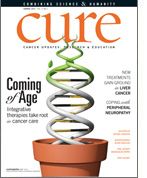Publication
Article
CURE
Finding the Positives in Negative Results
Author(s):
Researchers need to learn more about the biology of liver cancer to develop better treatments.
Patients with advanced hepatocellular carcinoma (HCC) have poor survival odds and few treatment options. Nexavar (sorafenib), the only approved drug for this population, improves survival by about three months, illustrating the need for more and better options. Unfortunately, the bulk of recent phase 3 clinical trials in advanced HCC have proven no better than Nexavar at markedly improving patient survival.
These trials have included a variety of targeted drugs, including Sutent (sunitinib), which is approved to treat advanced kidney cancer, and investigational agents brivanib and linifanib. Chemotherapy regimens like FOLFOX (folinic acid, 5-FU [fluorouracil] and oxaliplatin), administered either as first-line treatment or after Nexavar stops working, are also being tested. Although it’s easy to simply conclude that nothing works against HCC, researchers need to learn more about its biology to develop better treatments.
Katie Kelley, an oncologist at the University of California, San Francisco, says it is very difficult to interpret the outcomes of these trials due to the inherent complexity of HCC as a cancer that almost always coexists with liver disease, such as cirrhosis or viral hepatitis. First, the early studies evaluating drug safety typically involved subjects who had intact liver function. Thus, the drug doses established by these studies could be much more toxic in patients with HCC who have impaired liver function, which makes it difficult to determine how well a drug works. The early studies also relied on tumor size as a standard of success, which is problematic for HCC, given that treatments such as Nexavar can prolong survival without measurably reducing the actual size of the lesion.
Kelley also points out that HCC is a mixed bag of cancers with diverse causes ranging from viral hepatitis to alcoholrelated cirrhosis, but many clinical trials lump all patients together. This heterogeneity could mask the benefits of a particular treatment in specific subsets of patients. Even with better patient stratification, it is difficult to perfectly match the treatment and control groups based on the cause and extent of disease.
Indeed, a phase 3 trial of Nexavar conducted on participants with advanced HCC in Asia resulted in uniformly lower survival rates and less of a survival benefit compared with a parallel study on participants in Europe and the Americas. Although the explanation is unclear, it’s important to consider that the prevailing cause of underlying liver disease in Asia is hepatitis B infection, while in the Western world it’s hepatitis C.
Thus, these completed trials might not have been for naught, as a closer look at the results according to the cause and extent of patients’ underlying liver disease might illuminate positive responses in particular subsets that were previously lost in the mix. And future studies that take these variables into careful consideration could produce more meaningful, and potentially more promising, results.
Researchers need to learn more about the biology of hepatocellular carcinoma to develop better treatments.






